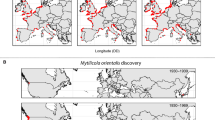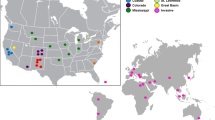Abstract
Do host invaders and their associated symbiont co-invaders have different genetic responses to the same invasion process? To answer this question, we compared genetic patterns of native and exotic populations of an invasive symbiont-host association. This is an approach applied by very few studies, of which most are based on parasites with complex life cycles. We used the mitochondrial genetic marker cytochrome oxidase subunit I (COI) to investigate a non-parasitic freshwater ectosymbiont with direct life-cycle, low host specificity and well-documented invasion history. The study system was the crayfish Procambarus clarkii and its commensal ostracod Ankylocythere sinuosa, sampled in native (N American) and exotic (European) ranges. Results of analyses indicated: (1) higher genetic diversity in the symbiont than its host; (2) genetic diversity loss in the exotic range for both species, but less pronounced in the symbiont; (3) native populations genetically structured in space, with stronger patterns in the symbiont and (4) loss of spatial genetic structure in the exotic range in both species. The combination of historical, demographic and genetic data supports a higher genetic diversity of source populations and a higher propagule size that allowed the symbiont to overcome founder effects better than its host co-invader. Thus, the symbiont might be endowed with a higher adaptive potential to new hosts or off-host environmental pressures expected in the invasive range. We highlight the usefulness of this relatively unexplored kind of symbiont-host systems in the invasion context to test important ecological and evolutionary questions.







Similar content being viewed by others
References
Allendorf FW, Lundquist LL (2003) Introduction: population biology, evolution, and control of invasive species. Conserv Biol 17:24–30
Avise JC (1994) Molecular markers, natural history and evolution, 2nd edn. Chapman & Hall, London
Baker JH (1969) On the relationship of Ankylocythere sinuosa (Rioja 1942) (Ostracoda, Entocytheridae) to the crayfish Procambarus simulans simulans (Faxon 1884). Trans Am Microsc Soc 88:293–294
Barbaresi S, Gherardi F, Mengoni A, Souty-Grosset C (2007) Genetics and invasion biology in fresh waters: a pilot study of Procambarus clarkii in Europe. In: Gherardi F (ed) Biological invaders in inland waters: profiles, distribution, and threats. Springer, Dordrecht, pp 381–400
Bazin E, Glémin S, Galtier N (2006) Population size does not influence mitochondrial genetic diversity in animals. Science 312:570–572
Bivand R, Piras G (2015) Comparing implementations of estimation methods for spatial econometrics. J Stat Softw 63:1–36
Blakeslee AM, Byers JE, Lesser MP (2008) Solving cryptogenic histories using host and parasite molecular genetics: the resolution of Littorina littorea’s North American origin. Mol Ecol 17:3684–3696
Blouin MS, Yowell CA, Courtney CH, Dame JB (1995) Host movement and the genetic structure of populations of parasitic nematodes. Genetics 141:1007–1014
Burbrink FT, Fontanella F, Pyron RA, Guiher TJ, Jimenez C (2008) Phylogeography across a continent: the evolutionary and demographic history of the North American racer (Serpentes: Colubridae: Coluber constrictor). Mol Phylogenet Evol 47:274–288
Castillo-Escrivà A, Mestre A, Monrós JS, Mesquita-Joanes F (2013) Population dynamics of an epibiont Ostracoda on the invasive red swamp crayfish Procambarus clarkii in a western Mediterranean wetland. Hydrobiologia 714:217–228
Charlesworth D (2003) Effects of inbreeding on the genetic diversity of populations. Philos Trans R Soc Lond Ser B 258:1051–1070
Combes C (2004) Parasitism: the ecology and evolution of intimate interactions. University of Chicago Press, Chicago
Cox GW (2004) Founder effects and exotic variability. In: Cox GW (ed) Alien species and evolution: the evolutionary ecology of exotic plants, animals, microbes, and interacting native species. Island Press, Washington, pp 32–46
Criscione CD, Blouin MS (2004) Life cycles shape parasite evolution: comparative population genetics of salmond trematodes. Evolution 58:198–202
Criscione CD, Poulin R, Blouin MS (2005) Molecular ecology of parasites: elucidating ecological and microevolutionary processes. Mol Ecol 14:2247–2257
Darriba D, Taboada GL, Doallo R, Posada D (2012) jModelTest 2: more models, new heuristics and parallel computing. Nat Methods 9:772
Dray S (2013) spacemakeR: spatial modelling. R package version 0.0-5/r113
Dray S, Dufour AB (2007) The ade4 package: implementing the duality diagram for ecologists. J Stat Softw 22:1–20
Dray S, Legendre P, Blanchet G (2013) packfor: forward selection with permutation (Canoco p.46). R package version 0.0-8/r109
Excoffier L, Dupanloup I, Huerta-Sánchez E, Foll M (2013) Robust demographic inference from genomic and SNP data. PLoS Genet 9:e1003905
Gaither MR, Aeby G, Vignon M, Meguro Y, Rigby M, Runyon C et al (2013) An invasive fish and the time-lagged spread of its parasite across the Hawaiian archipelago. PLoS ONE 8:e56940
Galpern P, Peres-Neto PR, Polfus J, Manseau M (2014) MEMGENE: spatial pattern detection in genetic distance data. Methods Ecol Evol 5:1116–1120
Goodall-Copestake W, Tarling G, Murphy E (2012) On the comparison of population-level estimates of haplotype and nucleotide diversity: a case study using the gene cox1 in animals. Heredity 109:50–56
Gotelli NJ, Colwell RK (2010) Estimating species richness. In: Magurran AE, McGill BJ (eds) Biological diversity: frontiers in measurement and assessment. Oxford University Press, Oxford, pp 39–54
Gutiérrez-Yurrita PJ, Martínez JM, Bravo-Utrera MA, Montes C, Ilhéu M, Bernardo JM (1999) The status of crayfish populations in Spain and Portugal. In: Gherardi F, Holdich DM (eds) Crayfish in Europe as alien species: How to make the best of a bad situation?. A. A. Balkema, Rotterdam, pp 161–192
Hart DG, Hart CW Jr (1974) The ostracod family Entocytheridae. Fulton Press Inc., Lancaster
Hobbs HH Jr (1972) Biota of freshwater ecosystems, identification manual 9: Crayfishes (Astacidae) of North and Middle America. US Environmental Protection Agency, Washington
Huey RB, Gilchrist GW, Carlson ML, Berrigan D, Serra L (2000) Rapid evolution of a geographic cline in size in an introduced fly. Science 287:308–309
Huner JV, Barr JAE (1991) Red swamp crayfish, biology and exploitation, 3rd edn. Louisiana State University, Baton Rouge
Jarne P (1995) Mating system, bottlenecks and genetic polymorphism in hermaphroditic animals. Genet Res 65:193–207
Jensen JD, Kim Y, DuMont VB, Aquadro CF, Bustamante CD (2005) Distinguishing between selective sweeps and demography using DNA polymorphism data. Genetics 170:1401–1410
Kolbe JJ, Larson A, Losos JB, de Queiroz K (2008) Admixture determines genetic diversity and population differentiation in the biological invasion of a lizard species. Biol Lett 4:434–437
Kouba A, Petrusek A, Kozák P (2014) Continental-wide distribution of crayfish species in Europe: update and maps. Knowl Manag Aquat Ecosyst 413:05
Legendre P (2014) lmodel2: model II regression. R package version 1.7-2
Li Y, Guo X, Cao X, Deng W, Luo W, Wang W (2012) Population genetic structure and post-establishment dispersal patterns of the red swamp crayfish Procambarus Clarkii in China. PLoS ONE 7:e40652
Librado P, Rozas J (2009) DnaSP v5: a software for comprehensive analysis of DNA polymorphism data. Bioinformatics 25:1451–1452
Lockwood JL, Cassey P, Blackburn T (2005) The role of propagule pressure in explaining species invasions. Trends Ecol Evol 20:223–228
McCoy KD, Boulinier T, Tirard C, Michalakis Y (2001) Host specificity of a generalist parasite: genetic evidence of sympatric host races in the seabird tick Ixodes uriae. J Evol Biol 14:395–405
Meirmans PG (2006) Using the AMOVA framework to estimate a standardized genetic differentiation measure. Evolution 60:2399–2402
Mestre A, Monrós JS, Mesquita-Joanes F (2011) Comparison of two chemicals for removing an entocytherid (Ostracoda: Crustacea) species from its host crayfish (Cambaridae: Crustacea). Int Rev Hydrobiol 96:347–355
Mestre A, Aguilar-Alberola JA, Baldry D, Balkis H, Ellis A, Gil-Delgado JA et al (2013) Invasion biology in non-free-living species: interactions between abiotic (climatic) and biotic (host availability) factors in geographical space in crayfish commensals (Ostracoda, Entocytheridae). Ecol Evol 3:5237–5253
Mestre A, Monrós JS, Mesquita-Joanes F (2014a) A review of the Entocytheridae (Ostracoda) of the world: updated bibliographic and species checklists and global georeferenced database, with insights into host specificity and latitudinal patterns of species richness. Crustaceana 87:923–951
Mestre A, Monrós JS, Mesquita-Joanes F (2014b) The influence of environmental factors on abundance and prevalence of a commensal ostracod hosted by an invasive crayfish: are ‘parasite rules’ relevant to non-parasitic symbionts? Freshw Biol 59:2107–2121
Mestre A, Castillo-Escrivà A, Rueda J, Monrós JS, Mesquita-Joanes F (2015) Experimental spillover of an exotic ectosymbiont on an European native crayfish: the importance of having a chance. Hydrobiologia 755:225–237
Miura O, Torchin ME, Kuris AM, Hechinger RF, Chiba S (2006) Introduced cryptic species of parasites exhibit different invasion pathways. Proc Natl Acad Sci USA 103:19818–19823
Mulligan CJ, Kitchen A, Miyamoto MM (2006) Comment on “Population size does not influence mitochondrial genetic diversity in animals”. Science 314:1390
Novak SJ, Mack RN (2005) Genetic bottlenecks in alien plant species: influence of mating systems. In: Sax DF, Stachowicz JJ, Gaines SD (eds) Species invasions: insights into ecology, evolution, and biogeography. Sinauer Associates Inc, Sunderland, pp 201–228
Oksanen J, Blanchet FG, Kindt R, Legendre P, Minchin PR, O’Hara RB et al (2015) vegan: community ecology package. R package version 2.2-1
Paradis E (2010) pegas: an R package for population genetics with an integrated-modular approach. Bioinformatics 26:419–420
Paradis E, Claude J, Strimmer K (2004) APE: analyses of phylogenetics and evolution in R language. Bioinformatics 20:289–290
Paulson EL, Martin AP (2014) Discerning invasion history in an ephemerally connected system: landscape genetics of Procambarus clarkii in Ash Meadows, Nevada. Biol Invasions 16:1719–1734
Poulin R (2007) Evolutionary ecology of parasites, 2nd edn. Princeton University Press, Princeton
Poulin R, Morand S (2005) Parasite biodiversity. Smithsonian Institution Scholarly Press, Washington
Roy HE, Handley LJL (2012) Networking: a community approach to invaders and their parasites. Funct Ecol 26:1238–1248
Sax DF, Stachowicz JJ, Brown JH, Bruno JF, Dawson MN, Gaines SD et al (2007) Ecological and evolutionary insights from species invasions. Trends Ecol Evol 22:465–471
Siesa ME, Manenti R, Padoa-Schioppa E, Bernardi FD, Ficetola GF (2011) Spatial autocorrelation and the analysis of invasion processes from distribution data: a study with the crayfish Procambarus clarkii. Biol Invasions 13:2147–2160
Stefani F, Aquaro G, Azzurro E, Colorni A, Galli P (2012) Patterns of genetic variation of a Lessepsian parasite. Biol Invasions 14:1725–1736
Tamura K, Nei M (1993) Estimation of the number of nucleotide substitutions in the control region of mitochondrial DNA in humans and chimpanzees. Mol Biol Evol 10:512–526
Tamura K, Stecher G, Peterson D, Filipski A, Kumar S (2013) MEGA6: molecular evolutionary genetics analysis version 6.0. Mol Biol Evol 30:2725–2729
Torchin ME, Lafferty KD, Dobson AP, McKenzie VJ, Kuris AM (2003) Introduced species and their missing parasites. Nature 421:628–630
Untergrasser A, Cutcutache I, Koressaar T, Ye J, Faircloth BC, Remm M, Rozen SG (2012) Primer3—new capabilities and interfaces. Nucleic Acids Res 40:e115
Vavrek MJ (2011) Fossil: palaeoecological and palaeogeographical analysis tools. Palaeontol Electron 14:1T
Wares JP, Hughes AR, Grosberg RK (2005) Mechanisms that drive evolutionary change: insights from species introductions and invasions. In: Sax DF, Stachowicz JJ, Gaines SD (eds) Species invasions: insights into ecology, evolution, and biogeography. Sinauer Associates Inc, Sunderland, pp 229–258
Young W (1971) Ecological studies of Entocytheridae (Ostracoda). Am Midl Nat 85:399–409
Yue GH, Li J, Bai Z, Wang CM, Feng F (2010) Genetic diversity and population structure of the invasive alien red swamp crayfish. Biol Invasions 12:2697–2706
Zhang Z, Schwartz S, Wagner L, Miller W (2000) A greedy algorithm for aligning DNA sequences. J Comput Biol 7:203–214
Acknowledgments
We thank Josep Antoni Aguilar-Alberola, Maria Antón, Marco Arruej, Andreu Castillo, Andreu Escrivà, Jose Antonio Gil-Delgado, Cristina Molina, Adrian Ponz, Josep R. Roca, Olivier Schmit, Luis Valls, Laia Zamora, Noel Novelo, Jonathan L. West, Will Sheftal, Julie Delabbio, Taren Manley, Mike Kennedy, Shirley and Shai for their help in the fieldwork; Andy Kruppa, Gavin Horsburgh and Barbara Morrissey for their assistance in the lab; Laurent Excoffier and Ivan Scotti for their help in coalescent simulation analyses. This research was funded by the Spanish Ministry of Science and Innovation Project ECOINVADER (CGL2008-01296/BOS) and the University of Valencia (“V-Segles” predoctoral grant to A. Mestre).
Author information
Authors and Affiliations
Corresponding author
Electronic supplementary material
Below is the link to the electronic supplementary material.
Rights and permissions
About this article
Cite this article
Mestre, A., Butlin, R.K., Kelso, W.E. et al. Contrasting patterns of genetic diversity and spatial structure in an invasive symbiont-host association. Biol Invasions 18, 3175–3191 (2016). https://doi.org/10.1007/s10530-016-1207-1
Received:
Accepted:
Published:
Issue Date:
DOI: https://doi.org/10.1007/s10530-016-1207-1




